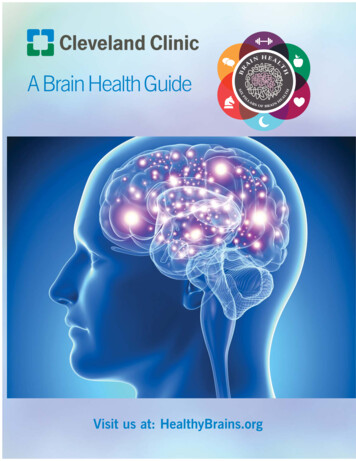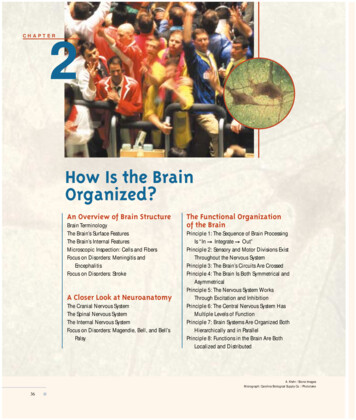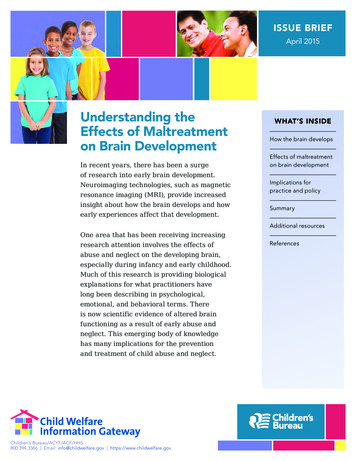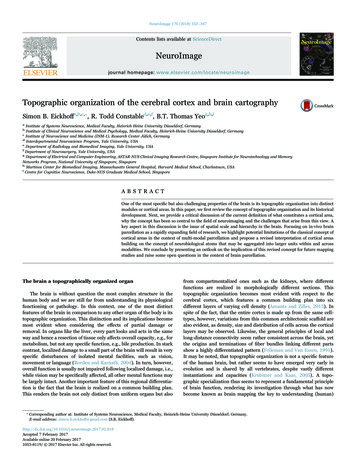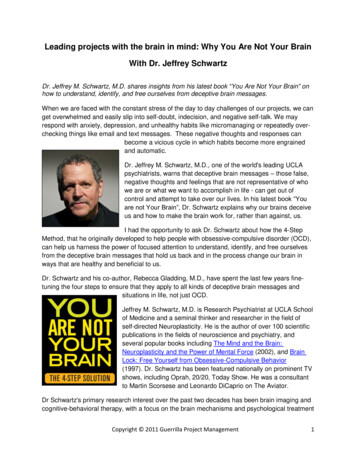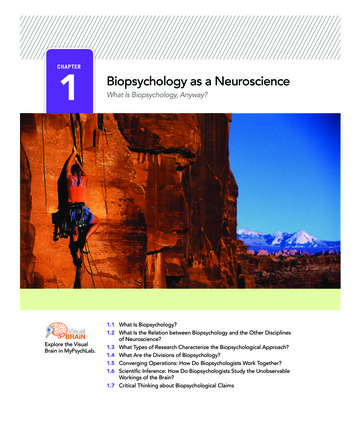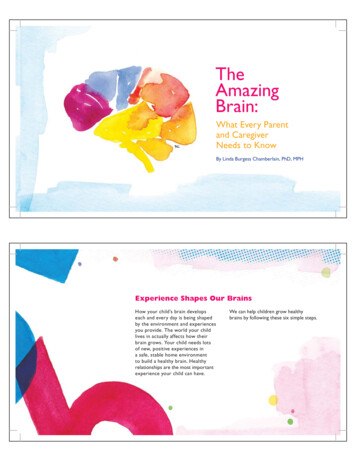
Transcription
TheAmazingBrain:What Every Parentand CaregiverNeeds to KnowBy Linda Burgess Chamberlain, PhD, MPHExperience Shapes Our BrainsHow your child’s brain developseach and every day is being shapedby the environment and experiencesyou provide. The world your childlives in actually affects how theirbrain grows. Your child needs lotsof new, positive experiences ina safe, stable home environmentto build a healthy brain. Healthyrelationships are the most importantexperience your child can have.We can help children grow healthybrains by following these six simple steps.
Help Me Make ConnectionsA baby’s brain is ready to connect.Babies build their brains by connectingwith you and the world around them.At birth, a baby’s brain has 100 BILLIONnerve cells called neurons that are waitingto connect. Each neuron can makethousands of connections or only a fewdepending on a child’s environment andexperiences. Spending quality time withyour child can increase your child’s brainpower. You can help your baby buildbrain connections by talking, hugging,singing, reading, playing, and exploringthe world together.The brain is a “use it or lose it”machine. There are windows ofopportunity in early brain development.Some of these windows close veryquickly. For example, areas of the braininvolved in vision are connected by 18months of age. If an infant’s vision isblocked by a cataract or an eye patchat the time when the brain needs to bemaking connections for vision, a childwill lose the ability to ever see out ofthe affected eye.Be There For MeHealthy, caring relationships are foodfor a child’s growing brain. By 6 monthsof age, babies can tell the differencebetween faces they know and don’t knowjust as well as you can! By 18 months ofage, the areas of the brain that controlemotions are connecting. Babies learnabout healthy relationships and how tohandle stress from you, so if you arestressed, your baby will be too. Your childneeds you to love them, comfort them,and encourage them. Make sure thatother caregivers are also providing a safe,nurturing environment for your child.Children need the right experienceat the right time. Learn as muchas you can about age-appropriateactivities to take advantage of windowsof opportunity for your child’s braindevelopment. For example, childrencan learn to speak a second languagewithout an accent. This windowof opportunity starts to close as ateenager and it becomes much harderto learn and speak a second languagewithout an accent.
Understand TheBuilding Blocks Of My BrainA child’s brain develops from thebottom up like a stack of building blocks.The brainstem and mid-brain are thefirst areas of the brain to develop andconnect. These areas are called the“survival brain” because they controlbody functions that keep us alive suchas blood pressure and body temperature.The limbic system is the next buildingblock of the brain. When you have a“gut response” about something, thiscomes from the limbic system in yourbrain which handles our basic emotions.The top building block of the brain isthe cortex. This is the last area of thebrain to mature. The cortex is responsiblefor our most complicated thinkingfrom decision-making to multi-taskingto controlling our emotions. Reading,writing, language, and arithmetic are allcortex functions so children need tospend lots of time in this area of theirbrains to learn these new skills.Build My Self-EsteemIntellectualBrainSurvivalBrainIt’s more than just words. We canbuild a child’s self-esteem throughpraise, encouragement, and positiveexperiences. Children need to hear thatwe believe in them and that they can bewhatever they want to be. Give yourchild opportunities to succeed at newtasks and develop skills. From praisingyour child for sharing a toy with anotherchild to teaching them how to climb upthe stairs, your encouraging words canboost your child’s confidence and abilityto face challenges.
I Need To Feel SafeChildren need to feel safe. Creatinga safe home isn’t just the things youdo to prevent your child from gettinghurt such as plugging outlets, puttingsafety gates on stairways, and keepingpoisons out-of-reach. It’s about creatinga predictable, stable environment foryour child. When a child feels safe andnurtured, they can focus their energy onupper brain development and learning.Children growing up in fear or chaostend to spend more time in “survivalbrain” trying to feel OK. They adaptto their environment, but it comes ata high cost. Because these childrenare spending less time in the cortexor “thinking brain,” they often haveproblems paying attention, sitting still,and controlling their emotions.Keep Being There!There are big brain changes duringadolescence. Adolescents do not haveall the hardware in their brains yet tothink like an adult. The adolescent braingoes through major remodeling thatstarts around puberty and continues intothe early 20’s. Teens need parents andcaregivers in their lives more than everto help them finish building their brains.How teens spend their time matters!
Some Information You Should KnowA baby’s brain usesTHREE TIMES the amountof energy that your braindoes—that’s a busy brain!!By 6 years of age, a child’sbrain will be 95% of itsadult size and have moreconnections than all the starsand planets in the galaxies.Children who watchmore television duringthe first three years of lifeare more likely to haveproblems with attentiondeficit disorders whenthey are 7 to 9 years old.Resources For Help And Additional InformationBrainConnection.comThis Web site provides information about how the brain works and howpeople learn. Many discoveries are being made in areas that relate to thehuman brain, including language, memory, behavior, and aging, as well asillness and injury. BrainConnection.com also provides practitioner-friendlytools for teaching and learning.www.Brainconnection.comChild Trauma AcademyThe Child Trauma Academy, a not-for-profit organization based in Houston,Texas, is a collaborative of individuals and organizations working to improvethe lives of high-risk children through direct service, research and education.www.childtrauma.orgThe National Child Traumatic Stress NetworkThe NCTSN was established to improve access to care, treatment, and servicesfor traumatized children and adolescents exposed to traumatic events.www.nctsnet.orgThe Philadelphia CompactThe Philadelphia Compact is a coalition of City agencies, community leaders,and service organizations working together and playing an ongoing role toensure all children living in our city have access to quality, affordable, andappropriate behavioral health his site offers a comprehensive interactive resource for parents and earlychildhood education professionals on healthy development of children ageszero to three.www.zerotothree.org
.VMUJQMZJOH POOFDUJPOTThe Amazing Brain: What Every Parent andCaregiver Needs to Know, 2008, Philadelphia,PA. This brochure was written by Linda BurgessChamberlain, PhD, MPH with support fromthe Institute for Safe Families and MultiplyingConnections of the Health Federation ofPhiladelphia.Linda Burgess Chamberlain is the foundingdirector of the Alaska Family Violence PreventionProject. An epidemiologist specializing in domesticviolence, she is an internationally recognizedspeaker on the effects of violence on childrenand brain development. She lives on a ruralhomestead outside of Homer, Alaska with herdog team. A national Kellogg Leadership Fellow,Dr. Chamberlain is also a motivational speakerand uses “lessons from the trail” to promote keystrategies for teamwork and leadership.howlinghusky@gci.netThe Institute for Safe Families (ISF) is anon-profit organization whose mission is toprevent family violence and promote the healthand well being of each member of the familyand their community. Since the early 1990’s,ISF has developed innovative programming andbuilt coalitions that unite health care providerswith social service, policy experts, researchers,academicians, and victim/survivors. One ofISF’s unique strengths has been to createforums for cross-systems dialogue aimed atbuilding greater capacity for more effectiveprevention and response to family ng Connections of The HealthFederation of Philadelphia is a cross systemcollaborative whose mission is to translatethe research on early childhood braindevelopment into better practice throughprofessional training and organizationaland policy change. Multiplying Connectionsis developing materials and strategies topromote trauma informed and developmentallyappropriate care across the public childand family service system in the City ofPhiladelphia. This capacity building initiativeis funded by the William Penn Foundation.www.multiplyingconnections.orgDesign and Illustration: Peter CamburnAbout Face Design www.aboutfacedesign.net
The Amazing Brain: What Every Parent and Caregiver Needs to Know, 2008, Philadelphia, PA. This brochure was written by Linda Burgess Chamberlain, PhD, MPH with support from the Institute for Safe Families and Multiplying Connections of the Health Federation o




